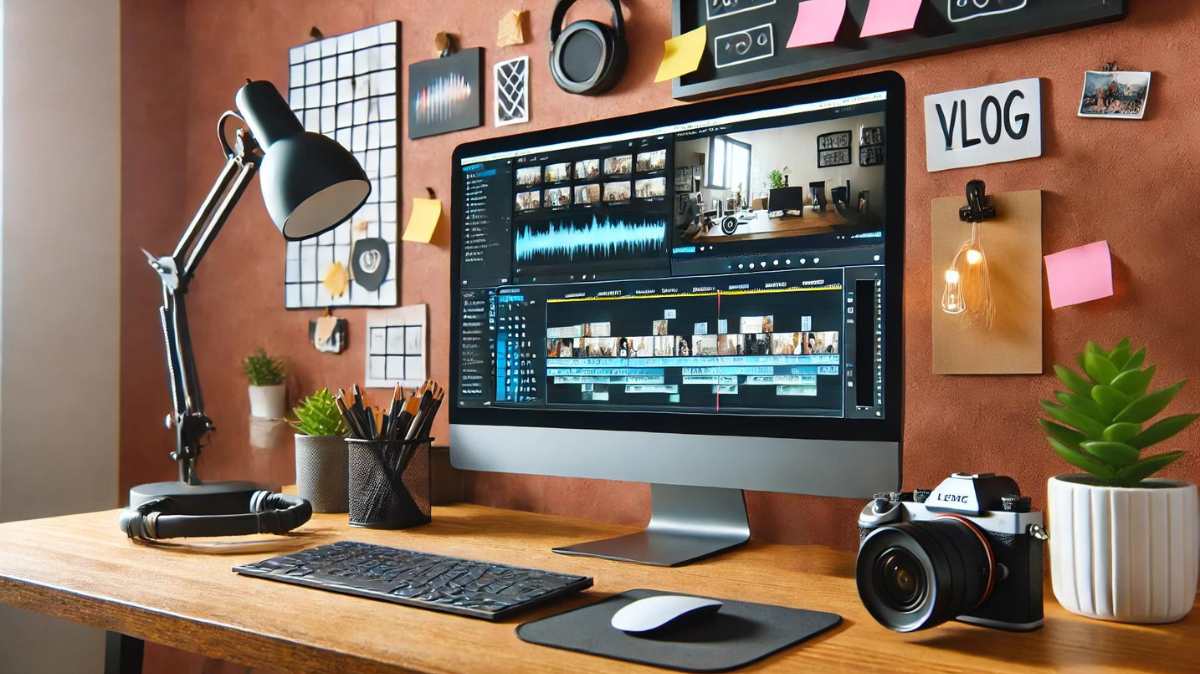Vlogging has become an art form—whether you’re a seasoned creator or just starting out, how you edit your videos can make or break your content. Sure, shooting footage is essential, but the vlog editing techniques you employ are what truly transforms your raw clips into cinematic magic. So, buckle up as we dive into the world of editing, where we mix storytelling, creativity, and a bit of technological wizardry.
Table of Contents
Why Vlog Editing Matters
Before we explore into specific techniques, let’s address the elephant in the room: why does vlog editing even matter? Simple answer—attention spans are short! Your audience might forgive a shaky shot or a slightly off soundbite, but they won’t sit through a poorly edited video. Editing helps to:
- Enhance storytelling: Great edits guide viewers through your narrative.
- Set the pace: A well-timed cut can keep things snappy and engaging.
- Fix mistakes: Bad takes? Low lighting? No problem—editing has your back.
More importantly, top-notch vlog editing differentiates you from the endless sea of content out there. So, let’s get into it!
1. Mastering Jump Cuts for Vlogs
Jump cuts are the bread and butter of vlogging. They’re a rapid cut between two pieces of footage, often used to eliminate dead air or unnecessary dialogue. Instead of letting your video drag on, jump cuts keep things tight, fast-paced, and engaging.
How to Use Jump Cuts Effectively
- Avoid Overuse: Too many jump cuts can become jarring and disorienting. Strike a balance to keep the viewer engaged without making them feel seasick.
- Add a Touch of Flair: Spice up jump cuts with subtle zoom-ins, sound effects, or even motion blur transitions. These little tweaks can make each cut feel intentional rather than haphazard.
For a deeper dive into the mechanics of jump cuts, this guide on video editing techniques is a great resource.
2. B-Roll: The Unsung Hero of Vlog Editing
B-roll footage is your secondary footage that supports your main shots. It’s often used to cover up cuts, make transitions smoother, or add context to what’s being talked about. For instance, if you’re describing your morning routine, a quick shot of you making coffee or brushing your teeth serves as the perfect B-roll.
Top B-Roll Tips
- Capture Variety: Shoot more B-roll than you think you’ll need. Different angles, perspectives, and focal lengths give you more options during editing.
- Use to Your Advantage: Is your main footage a bit shaky? A well-placed B-roll can hide imperfections and maintain the flow.
- Keep It Short: Remember, B-roll is there to support your narrative, not overshadow it.
Including high-quality B-roll elevates your vlogs, providing depth and visual interest. Read more about crafting compelling B-roll from this video production guide.
3. Smooth Transitions to Keep the Flow
There’s nothing worse than a jarring transition that makes your audience question if they’ve accidentally clicked on another video. Smooth transitions maintain the flow, giving your vlog a polished and professional feel.
Common Vlog Transition Styles
- Crossfade: One shot gradually fades into another. It’s simple but incredibly effective, especially for scene changes.
- Whip Pan: Fast-moving transitions that simulate the camera panning quickly from one shot to the next. It’s a dynamic, energetic choice that keeps the pace up.
- Fade to Black: This transition implies a pause or break in time. It’s perfect for chapter changes or conveying the passage of time.
For advanced transitions, many editors swear by Adobe Premiere Pro or Final Cut Pro’s transition libraries. Check out this Premiere Pro tutorial for hands-on tips.
4. Color Grading: Set the Mood
Color grading is where the magic happens. Adjusting the colors in your footage can entirely change the mood, tone, and feel of your vlog. You’ve probably noticed how professional vlogs have a “look” to them, right? That’s color grading at work.
Basic Color Grading Techniques
- Correct Your Colors: Before jumping into stylistic grading, make sure your footage is color corrected. This means adjusting for white balance, exposure, and contrast to get an even look.
- Choose a Style: Think about the mood you want. Warmer tones for sunny travel vlogs? Cooler tones for introspective moments? Use color to enhance the vibe.
- Use LUTs (Look-Up Tables): LUTs are pre-set color grades that can be applied to your footage. They’re like Instagram filters but for video!
For more advanced techniques, this color grading guide offers some fantastic tips.
5. Sound Design: Don’t Forget About Audio!
Audio is just as important as the visuals in any vlog. You might have the crispiest footage, but if your sound design is lacking, it’ll ruin the viewer experience.
Key Sound Design Elements for Vlogs
- Background Music: Choose royalty-free music that complements the mood without overpowering the dialogue. Websites like Epidemic Sound or Artlist offer high-quality tracks.
- Sound Effects: Subtle sound effects—like whooshes, clicks, or even ambient sounds—can add layers to your story. Don’t overdo it, but use them to enhance moments.
- Voiceovers: If you’re narrating, ensure the voiceover is clear and recorded with good equipment. A basic USB microphone can significantly boost sound quality.
For more on how to elevate your sound, check out this article on sound editing.
6. The Art of Vlog Titles and Text Overlays
Adding text overlays can add clarity, humor, or emphasis in your vlogs. For example, pop-up text can explain what’s happening on screen or give extra context for international viewers.
Best Practices for Text Overlays
- Less Is More: Don’t clutter the screen. Short, snappy text works best.
- Typography Matters: Choose clean, legible fonts that match your brand style. Bold, sans-serif fonts are popular choices for vlogs.
- Animate It: Subtle animations (like fade-ins or slide-ups) make text feel integrated and professional rather than an afterthought.
For tips on creative titles and overlays, look at YouTuber tutorials like this one from Peter McKinnon, who covers text animation tricks in depth.
7. Vlog Length: How to Know When Enough Is Enough
A common question among vloggers is: how long should my vlog be? While there’s no one-size-fits-all answer, it’s essential to keep in mind audience retention. Generally, most successful vlogs range between 8 to 15 minutes. But, as always, the key is quality over quantity.
How to Trim the Fat
- Cut Unnecessary Footage: Just because you filmed it doesn’t mean it needs to be included. Keep the content tight and focused on the story.
- Use B-Roll and Cutaways: If a part of your vlog drags on but has essential dialogue, consider covering it with B-roll or speeding it up.
- Ask for Feedback: Sometimes, it’s hard to see your own content’s flaws. Getting outside opinions can help you refine your edit.
8. The Power of Storytelling in Your Edits
At the heart of every great vlog is a compelling story. Editing plays a huge role in shaping that story. Whether it’s a travel vlog, a product review, or just a day in your life, story structure is key.
Editing with a Narrative Flow
- Start with a Hook: Capture attention within the first 10 seconds. This could be a teaser of what’s coming or an exciting moment from the middle of your vlog.
- Build Tension: Even in a casual vlog, you can build up to a climax. Maybe it’s the grand reveal of a new location or the punchline to a funny anecdote.
- End Strong: Leave viewers wanting more—end with a call-to-action (subscribe, comment, etc.) or a cliffhanger if it’s part of a series.
For further exploration into crafting narratives through edits, check out this narrative editing guide by Frame.io.
FAQs about Vlog Editing Techniques
Q1: How do I make my vlog stand out?
Use a unique editing style, mix creative transitions, and ensure your sound design is top-notch. Focus on storytelling to connect with your audience.
Q2: What’s the best software for vlog editing?
Popular software includes Adobe Premiere Pro, Final Cut Pro, and DaVinci Resolve. These tools offer professional-grade features for advanced edits.
Q3: How long should it take to edit a vlog?
It depends on the complexity. A basic vlog may take 4-6 hours to edit, while more intricate vlogs with heavy B-roll or effects can take upwards of 10-15 hours.
Q4: Can I edit vlogs on my phone?
Yes! Apps like LumaFusion and Kinemaster allow for high-quality mobile editing with many of the same features as desktop software.
Q5: How do I choose the right music for my vlog?
Pick music that fits the mood and tone of your vlog. Use royalty-free music platforms like Epidemic Sound or Artlist to avoid copyright issues.
Q6: How important are transitions in vlogs?
Transitions are crucial for maintaining flow and guiding your viewers. Smooth, well-placed transitions can elevate the quality of your vlog significantly.
Final Thoughts
Editing is where the real magic happens in vlogging. Whether you’re mastering jump cuts, crafting smooth transitions, or adding that perfect color grade, the techniques you use define the overall viewer experience. Start small, experiment, and remember: there’s no right or wrong—only what works best for your style and audience.
Author

An aspiring business leader, I am working towards my dream of graduating from Stanford University with a degree in Business Management. Passionate about sharing knowledge, I strive to empower others through education and collaborative learning.
View all posts


